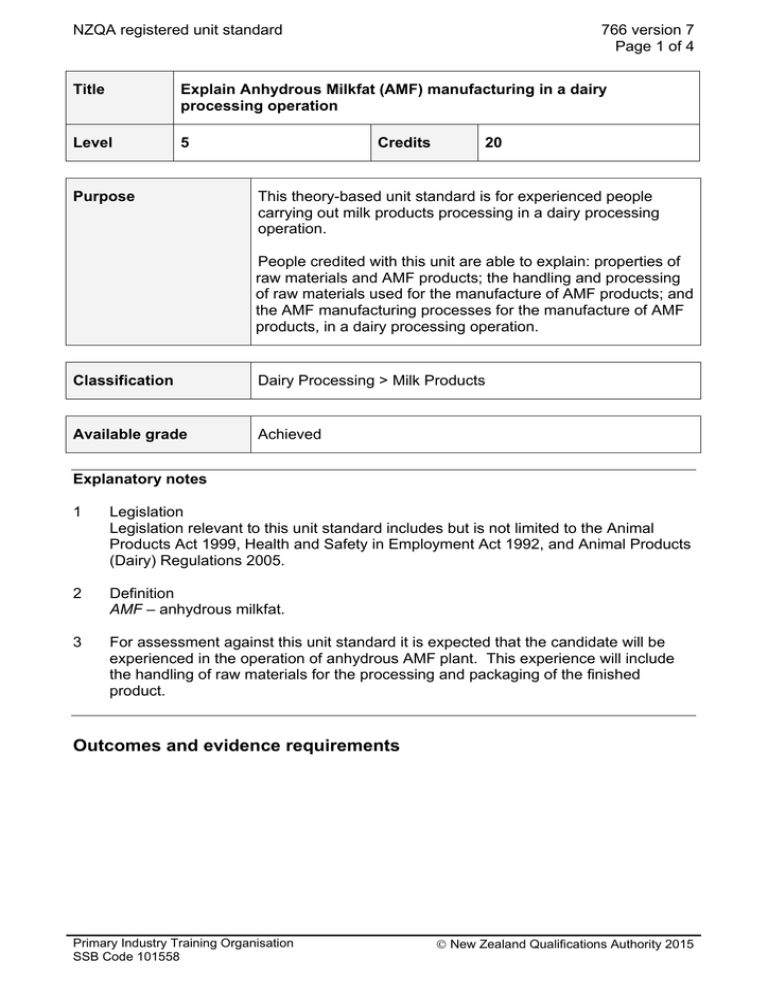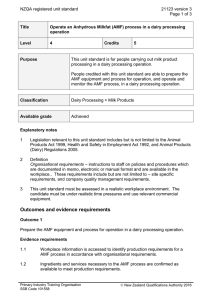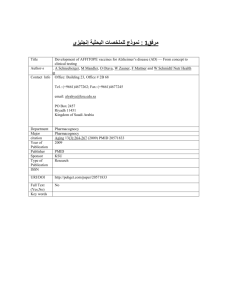Outcomes and evidence requirements
advertisement

NZQA registered unit standard 766 version 7 Page 1 of 4 Title Explain Anhydrous Milkfat (AMF) manufacturing in a dairy processing operation Level 5 Purpose Credits 20 This theory-based unit standard is for experienced people carrying out milk products processing in a dairy processing operation. People credited with this unit are able to explain: properties of raw materials and AMF products; the handling and processing of raw materials used for the manufacture of AMF products; and the AMF manufacturing processes for the manufacture of AMF products, in a dairy processing operation. Classification Dairy Processing > Milk Products Available grade Achieved Explanatory notes 1 Legislation Legislation relevant to this unit standard includes but is not limited to the Animal Products Act 1999, Health and Safety in Employment Act 1992, and Animal Products (Dairy) Regulations 2005. 2 Definition AMF – anhydrous milkfat. 3 For assessment against this unit standard it is expected that the candidate will be experienced in the operation of anhydrous AMF plant. This experience will include the handling of raw materials for the processing and packaging of the finished product. Outcomes and evidence requirements Primary Industry Training Organisation SSB Code 101558 © New Zealand Qualifications Authority 2015 NZQA registered unit standard 766 version 7 Page 2 of 4 Outcome 1 Explain properties of raw materials and AMF products in a dairy processing operation. Evidence requirements 1.1 Milk components are explained in terms of their influence on the AMF manufacturing process and on the properties of the final products. Range 1.2 Lipolysis and oxidation of milkfat are explained in terms of their influence on the AMF manufacturing process and on final AMF flavour and shelf-life. Range 1.3 properties include but are not limited to – sterols, vitamins, phospholipids, colouring compounds, fatty acids (short, medium, long, unsaturated), melting properties and crystallisation of triglycerides, seasonal variation. lipolysis and oxidation include but are not limited to – oxidation catalysts, peroxide value, free fatty acid, dissolved oxygen. Conditions for microbial contamination, growth and control are explained in terms of achieving AMF product and serum by-product specifications. Range contamination includes but is not limited to – pathogens, psychrotrophs, coliforms, thermophiles, yeasts and moulds. Outcome 2 Explain the handling and processing of raw materials used for the manufacture of AMF products in a dairy processing operation. Evidence requirements 2.1 Milk and cream handling are explained in terms of manufacture and meeting final product specifications of AMF products. Range 2.2 product specifications include but are not limited to – emulsion stability, fat globule membrane, gelling, microbial growth, lipolysis, neutralisation, solids not fat content. The purposes of cream or AMF pasteurisation are explained in terms of manufacturing and meeting final product specifications of AMF products. Range purposes include but are not limited to – flavour management, lipase inactivation, free fatty acids, peroxide value, shelf-life. Primary Industry Training Organisation SSB Code 101558 © New Zealand Qualifications Authority 2015 NZQA registered unit standard 766 version 7 Page 3 of 4 Outcome 3 Explain the AMF manufacturing processes for the manufacture of AMF products in a dairy processing operation. Evidence requirements 3.1 The components of AMF plants are explained in terms of the operating principles. Range 3.2 AMF plant variables are explained in terms of their effect on composition control and quality of AMF products. Range 3.3 cleaning performance includes but is not limited to – fat recovery, separator cleaning, chemicals, flow rates. Separator operation is explained in terms of equipment performance and operator safety. Range 3.6 silo holding and packing includes but is not limited to – nitrogen blanketing, AMF silo agitation, packing fill rate, temperature, filling lance, drum filling, net weights, headspace flushing. AMF plant cleaning and clean in place is explained in terms of cleaning performance and operator safety. Range 3.5 variables include but are not limited to – throughput, plant temperature, high fat cream fat content, homogenising pressure, recycle rates, separator back pressures, moisture content, caustic strength, mixing intensity, holding time, polishing water flow, dehydration temperature, vacuum, steam strip rate, dissolved oxygen content, process control, startup and shutdown. AMF silo holding and packing are explained in terms of product keeping quality, consistency, and pack integrity. Range 3.4 components include but are not limited to – cream pre-heating plate heat exchanger, butter melting system, cream concentrating separator, phase inversion device (homogeniser), concentrate separator, neutralising system, polishing separator, dehydrator, cooling plate heat exchanger, packing silo, packaging system, buttermilk separator, beta-serum separator. separator performance includes but is not limited to – separator design, separating efficiency, separation zone, back pressures, desludging, safe operating procedures. Quality control and final product grading are explained in terms of manufacturing AMF products to customer product purchase specifications. Range quality control and grading includes but is not limited to – trace back, sensory evaluation. Primary Industry Training Organisation SSB Code 101558 © New Zealand Qualifications Authority 2015 NZQA registered unit standard Planned review date 766 version 7 Page 4 of 4 31 December 2020 Status information and last date for assessment for superseded versions Process Version Date Last Date for Assessment Registration 1 10 January 1994 31 December 2012 Revision 2 16 September 1997 31 December 2012 Review 3 5 July 1999 31 December 2012 Revision 4 13 June 2003 31 December 2012 Rollover and Revision 5 20 June 2006 31 December 2014 Rollover 6 17 July 2009 31 December 2016 Review 7 18 June 2015 N/A 0022 Consent and Moderation Requirements (CMR) reference This CMR can be accessed at http://www.nzqa.govt.nz/framework/search/index.do. Please note Providers must be granted consent to assess against standards (accredited) by NZQA, before they can report credits from assessment against unit standards or deliver courses of study leading to that assessment. Industry Training Organisations must be granted consent to assess against standards by NZQA before they can register credits from assessment against unit standards. Providers and Industry Training Organisations, which have been granted consent and which are assessing against unit standards must engage with the moderation system that applies to those standards. Requirements for consent to assess and an outline of the moderation system that applies to this standard are outlined in the Consent and Moderation Requirements (CMR). The CMR also includes useful information about special requirements for organisations wishing to develop education and training programmes, such as minimum qualifications for tutors and assessors, and special resource requirements. Comments on this unit standard Please contact the Primary Industry Training Organisation standards@primaryito.ac.nz if you wish to suggest changes to the content of this unit standard. Primary Industry Training Organisation SSB Code 101558 © New Zealand Qualifications Authority 2015





